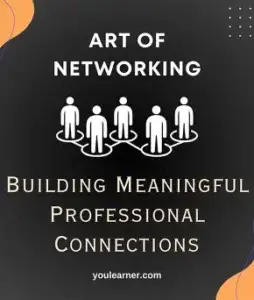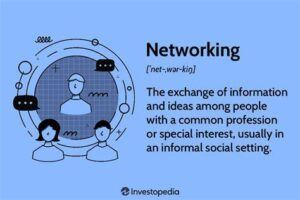Networking isn’t just a buzzword thrown around in business circles. It’s the backbone of building meaningful professional relationships that stand the test of time. But what really is networking? At its core, networking is about creating a community of people who share interests, experiences, and goals. It’s a two-way street where everyone has something to give and gain.

In today’s fast-paced business landscape, authentic connections matter more than ever. Think of networking as relationship-building rather than a transactional exchange. Authenticity sets the foundation for lasting connections. Building genuine relationships means focusing on mutual benefits and understanding the person behind the professional facade.
Myths about networking, like the idea that it’s reserved for extroverts or top executives only, can be misleading. Networking is for everyone—introverts, extroverts, and all career levels. It’s not about schmoozing or superficial interactions. It’s about building a support system that can help, whether you’re climbing the corporate ladder or starting a new venture.
Let’s not overlook the human aspect. Networking taps into psychology, understanding others, and connecting on a deeper level. It’s not just who you know but how well you know them and understand their needs too. This human connection makes networking both an art and a science, requiring emotional intelligence and genuine effort from all parties involved.
Setting Clear Intentions and Goals for Your Networking Efforts
Jumping into networking without a clear purpose can leave you wandering through professional circles aimlessly. Before you start shaking hands or sending connection requests, define what you want to achieve. Are you looking to expand your knowledge, find new opportunities, or maybe seek mentorship? Clearly outlined intentions steer your networking in the right direction.
Growth happens when your networking goals align with your core values and career objectives. Consider what really matters to you and how networking can support those priorities. This alignment ensures your interactions are genuine and focused on building meaningful relationships instead of mere transactions.

Setting goals isn’t just for productivity gurus. It’s a crucial step in fostering long-term connections. Envision where you want to be and work backwards. Whether it’s setting a target for how many new contacts you want to make or identifying organizations you want to engage with, specific goals keep you on track.
Keeping tabs on your progress doesn’t require fancy tools. A simple spreadsheet can do wonders for tracking who you’ve met, the conversations you’ve had, and future follow-ups. Regularly reviewing this can guide you in refining your approach and identifying areas for improvement. A network is a living entity that evolves, and paying attention to it helps sustain its vibrancy.
Cultivating and Demonstrating Strong Interpersonal Skills
Interpersonal skills are the bedrock of effective networking. These skills help you connect, communicate, and build rapport with others in any setting. Being able to engage confidently and comfortably with diverse individuals is what sets great networkers apart.
Empathy is a game-changer. It means genuinely trying to understand and share the feelings of others. It allows you to connect on a human level, making your interactions more personal and meaningful. Empathic listening creates an atmosphere of trust and respect, essential for any rewarding relationship.

Non-verbal communication often speaks louder than words. Your body language, eye contact, and facial expressions play a huge role in how your message is received. Understanding these cues can help you convey openness and confidence, leading to more engaging and effective interactions.
Networking situations can sometimes trigger social anxiety, even for the most seasoned professionals. It’s completely normal. Overcoming this begins with preparation and practice. Engage in role-playing or low-stakes networking settings to build confidence. Remember, everyone started somewhere, and feeling comfortable in your own skin is key.
Mastering the Art of Small Talk and Meaningful Conversations
Small talk often gets a bad rap, but it’s actually the gateway to deeper conversations. Think of it as the appetizer before the main course — it sets the tone for more substantial interactions. Being well-versed in starting light, engaging conversations can open many doors in your professional journey.
Breaking the ice doesn’t have to feel awkward. Sometimes, a simple observation about the surroundings or a comment on a recent event can kick things off. Remember, the goal is to spark interest, not deliver a speech. Even the smallest of topics can lead to meaningful discussions with the right approach.
Developing rapport quickly is all about finding common ground. Pay attention to shared interests or experiences that can lay the foundation for a strong connection. This creates a natural flow to the conversation and makes it easier to shift from small talk to topics with more depth.

Talking isn’t the only skill needed here. A good conversation is a two-way street. Listening actively shows that you value the other person’s input, making them feel heard and appreciated. Striking the right balance between speaking and listening ensures the dialogue is engaging for everyone involved.
Turning chit-chat into substantial discussions involves asking the right questions. Open-ended questions encourage elaboration and can reveal shared interests or insights. Before you know it, a casual exchange can evolve into a rewarding conversation with real impact.
Networking in the Digital Age: Utilizing Online Platforms
In today’s world, online networking is just as crucial as face-to-face interactions. With the rise of digital communication, mastering online platforms can significantly broaden your networking horizon. Having an active presence in these spaces can connect you with industry peers, mentors, and potential clients around the globe.
LinkedIn is more than just an online resume—it’s a dynamic tool for professional networking. Regularly updating your profile, sharing industry-specific content, and engaging with others’ posts can enhance your visibility and authority in your field. Don’t be shy about reaching out for connections; many great networking opportunities begin with a simple message.

Virtual networking events are on the rise, offering a plethora of benefits: they save travel time, expand your reach, and often provide interactive features that in-person events can’t. Participating actively in these environments, such as webinars or online mixers, can yield connections that translate into real-world success.
Crafting a compelling online presence involves showcasing your personality and expertise authentically. This goes beyond the professional headshot or polished bio. Think about how you express your voice in posts and engagements. Authenticity online is just as attractive as it is in person, so let your genuine self shine through.
Navigating digital interactions requires an understanding of netiquette—online etiquette norms. Respectful communication, thoughtful responses, and timely follow-ups ensure that your digital footprint is positive and professional. Remember, the online world may be vast, but it’s important to maintain the same level of authenticity and respect as in face-to-face interactions.
Building and Maintaining a Diverse and Strong Network
A diverse network isn’t just about checking boxes—it’s about gaining a variety of perspectives, insights, and opportunities. Engaging with people from different industries, cultures, and backgrounds enriches your network and enhances creativity, leading to innovative solutions and new ideas.
Sustaining these connections requires ongoing effort and intention. Regular check-ins, whether through a quick message or a coffee catch-up, can make a big difference. It shows that you value the relationship beyond transactional interactions.
Reciprocity is the heart of healthy networking. Offering support, sharing resources, or even passing along an opportunity shows you’re invested in mutual growth. Building trust through generous actions often leads to stronger, more productive relationships.
Collaboration creates win-win scenarios and propels everyone involved forward. When you combine diverse skill sets and knowledge bases, the outcome is often a richer, more successful endeavor. Being open to teamwork and sharing the stage can open doors to unimagined possibilities.
Leveraging Follow-ups to Strengthen Connections
Follow-ups are more than just polite gestures; they’re key to reinforcing connections and keeping the conversation going. A timely follow-up shows diligence and respect for the relationship, leaving a positive impression long after the initial meeting.
Crafting a personalized follow-up message—whether it’s by email, LinkedIn, or a handwritten note—speaks to your genuine interest in the connection. Mention specific details from your conversation to personalize the message, making it clear that this isn’t just a copy-pasted blurb.
All your computer needs
https://intimebiztraining.com/digital-transfor…iness-operations/
All your video recording equipment
https://intimebiztraining.com/maximizing-train…-and-scalability/
All your projector needs
https://intimebiztraining.com/enhancing-traini…ctor-integration/
There are numerous tools and apps to help streamline your follow-up process. They can automate reminders, track correspondences, and even suggest personalized content based on past interactions. These tools take the hassle out of remembering who to contact and when.
An initial meeting is just the beginning. Transforming those connections into meaningful, reliable relationships requires consistent effort. Making follow-ups part of your routine ensures that connections remain active and can grow stronger over time. Each contact holds the potential to develop into a trusted ally or colleague in your professional journey.
Learning from Mistakes: Networking Pitfalls to Avoid
Everyone stumbles, but it’s how you pick yourself back up that counts. Recognizing and avoiding common networking mistakes can save you from setbacks and bolster your efforts. A big blunder is being overly transactional—treating people like stepping stones rather than individuals with value to offer. Genuine interest in others builds real bonds.
We’ve all experienced networking failures. Missed opportunities or awkward interactions are part of the learning curve. Embrace these moments as lessons rather than losses. Identifying what went wrong and adjusting your approach is crucial for growth.
Resilience is your best friend in the world of networking. Persistence and a willingness to keep trying despite setbacks give you the edge. Every “no” can bring you closer to a “yes,” and every misstep brings valuable insights.
All your training needs: Intime Biz Training
visited also
The Magic Of Success: How To Unlock A Limitless Mindset And Achieve Your Goals”
Success stories from seasoned networkers are packed with valuable lessons. Examine how they overcame obstacles and missteps in their networking journeys. These real-world examples can inspire you to push through challenges and refine your networking skills, leading you to fruitful and fulfilling professional relationships.
